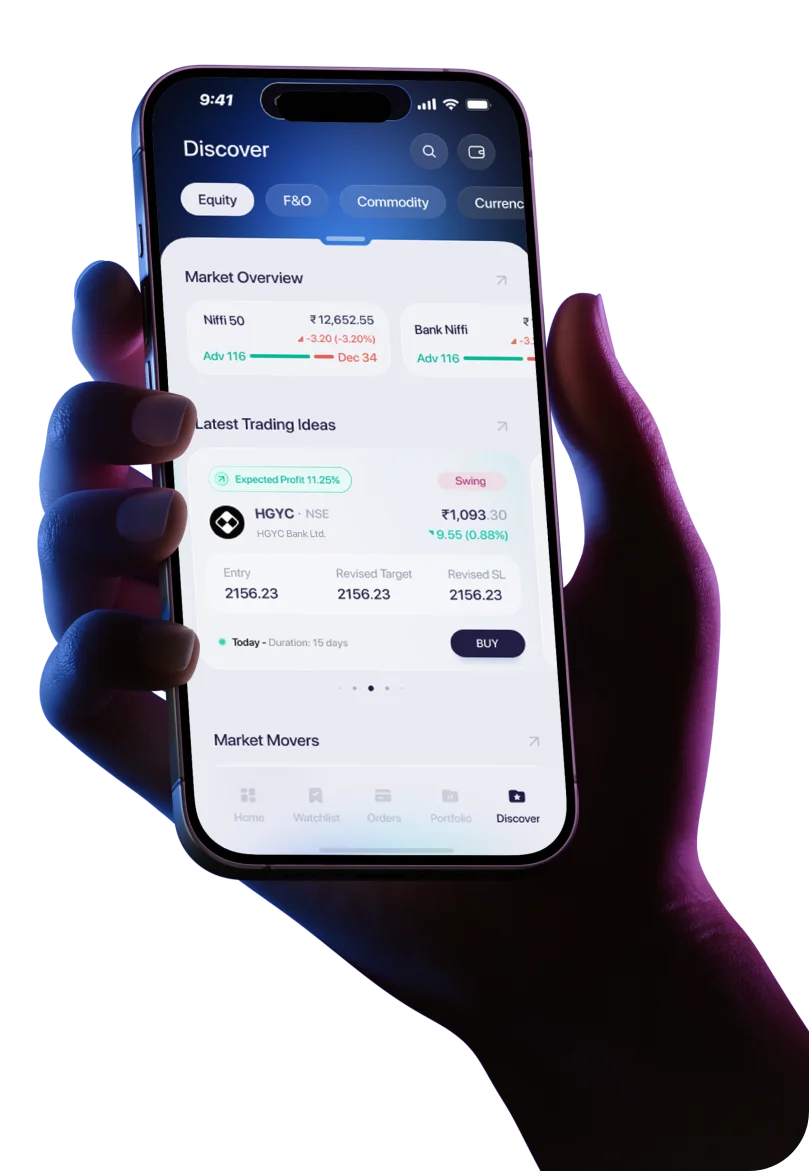The Nifty 50 is one of the two major broad market benchmark indices in the Indian stock market. Established in 1996 as the flagship index of the National Stock Exchange (NSE), it is composed of the 50 largest companies trading on this bourse. These companies belong to various sectors, making the Nifty 50 a reliable representation of the market’s overall pulse.
Historically, the Nifty 50 has performed strongly over the years and mirrored India's economic growth nearly accurately. For instance, in the fiscal year ending March 31, 2024, the index surged nearly 29%, marking its best performance since the post-COVID rebound in 2021. This impressive growth was driven by strong macroeconomic indicators and substantial foreign portfolio investments.
Investing in the Nifty 50 can be a straightforward way to gain exposure to India's top companies because it offers diversification across key industries. If you want to know how to invest in the Nifty 50, this article can give you the answers you need.
By investing in this benchmark index, you can participate in the country's economic expansion through a single investment vehicle. Read on to learn more about direct Nifty 50 investments, see how to invest in the Nifty 50 fund and understand the benefits of these strategies.
The Different Ways to Invest in the Nifty 50
Now that you understand the meaning and significance of this benchmark index, let us explore how to invest in the Nifty 50 in practical terms. There is more than one method by which you can do this.
You can choose from the following methods based on your investment goals, risk appetite and the level of involvement you are comfortable with.
Direct Investment via Nifty 50 Stocks
This is one of the most effective ways to mirror the NSE’s benchmark index. If you are exploring how to invest in the Nifty 50 while retaining full control over your portfolio, this route gives you exactly that — along with the responsibility that comes with it.
Here, you purchase the individual stocks that make up the index in the same weightage they hold within the Nifty 50. So, this method essentially replicates the performance of the index because it aligns your portfolio with the index’s composition. However, active monitoring is required because you will need to rebalance your portfolio whenever there are any changes in the index.
This approach may be ideal for you if:
- You are an experienced investor who understands portfolio balancing
- You have the time to manage your investments actively
- You can afford a higher capital outlay (because you will have to purchase 50 stocks outright)
Index Funds
Index funds are a type of mutual funds that mirror and track specific market indices. In this case, a Nifty 50 index fund invests in all the 50 companies that make up the index, in the same proportion. Since it passively tracks the index, its returns closely match the overall market movement.
When you choose this option, you do not need to pick individual stocks or time the market. Instead, the fund manager does the tracking for you. This makes index funds ideal if you want broad exposure to India’s top companies without actively managing your investments. Learning how to invest in the Nifty 50 index fund is often the first step for passive investors.
Here are the top benefits of choosing a Nifty 50 index fund for your portfolio:
- Low Cost: Since these are passively managed investments, index funds usually have lower expense ratios than actively managed mutual fund schemes.
- Passive Investing: You do not need to monitor the market daily. The fund simply mirrors the Nifty 50 and the manager adjusts the composition as needed.
- Built-in Diversification: With a single Nifty 50 index fund, you gain exposure to 50 of India's largest companies across various sectors.
If you want to reap these benefits and make the most of funds that track this benchmark index, you need to know how to invest in the Nifty 50 index fund. Here is a handy guide to help you get started:
- Step 1: Pick a Reputable Fund House: Look for trusted AMCs (Asset Management Companies) with a solid track record.
- Step 2: Check the Expense Ratio: Lower expense ratios mean that less of your returns will go towards meeting the costs of investments.
- Step 3: Choose Your Investment Mode: You can invest a lump sum or set up a Systematic Investment Plan (SIP) for regular contributions.
- Step 4: Use a Trusted Investment Platform: Complete your investment via an AMC website, online brokerage or investment app.
This sums up the fundamentals that you must know about how to invest in the Nifty 50 index fund.
Exchange-Traded Funds (ETFs)
This method is ideal if you want real-time control while figuring out how to invest in the Nifty 50 efficiently. ETFs or Exchange-Traded Funds are marketable securities that track an index like the Nifty 50. However, they are traded on stock exchanges just like individual shares.
While similar to index funds in structure, ETFs offer more flexibility in trading and typically have even lower expense ratios. When you buy a Nifty 50 ETF, you are essentially purchasing a unit that reflects the index’s performance. These units can be bought and sold throughout the trading day at market prices.
Before you decide how to invest in the Nifty 50, here are some reasons why ETFs might work for you:
- Real-Time Trading: ETF units can be bought and sold at any time during the market hours, unlike mutual funds which are settled only once a day.
- Lower Expense Ratios: Since ETFs are passively managed and do not involve active fund management, their costs are generally lower.
- High Liquidity: Nifty 50 ETFs tend to have good trading volumes, making it easy to enter or exit your position without much price slippage.
Derivatives (Futures & Options)
If you are exploring how to invest in the Nifty 50 through active trading strategies, derivatives like futures and options offer the flexibility needed. However, they demand significant skill and discipline.
With futures and options, you can trade on the Nifty 50’s future value without actually owning the underlying stocks. These instruments are commonly used for speculation or hedging and are best suited for experienced traders chasing short-term gains. However, they come with significantly higher risks due to market volatility and high leverage requirements.
Factors to Consider Before Investing in the Nifty 50
To make a smarter choice about how to invest in the Nifty 50, it is important to take stock of a few personal and market-related factors. Here are the key parameters to keep in mind before putting your money into Nifty 50-linked investments:
Risk Appetite:
The index can be volatile in the short term. So, make sure you understand the market and can tolerate the ups and downs.
Investment Horizon:
Nifty 50 investments tend to reward long-term investors who stay invested through various market cycles. So, only opt for this if you have a long-term outlook.
Expense Ratio:
Even small differences in the cost of investing can impact your returns over time. So, try to opt for funds that have lower expense ratios.
Fund Performance:
Check how the funds you want to invest in have tracked the index historically before you commit your money to any mutual fund or ETF scheme.
How to Start Investing in the Nifty 50?
Once you have decided how to invest in the Nifty 50, the next step is to actually put that plan into action. Whether you are going to invest through mutual funds, ETFs or direct stocks, it’s essential to know how to invest in the Nifty 50 practically. Here is how you can get started:
- Step 1: Open a demat and trading account with a brokerage partner of your choice.
- Step 2: Choose between direct stocks, index funds and ETFs.
- Step 3: If you choose mutual funds or ETFs, analyse the scheme’s performance, expense ratio and tracking error.
- Step 4: Invest in the index fund with a SIP or make a lump sum investment according to your convenience.
Benefits of Investing in the Nifty 50 Index
If you are exploring how to invest in the Nifty 50, it is just as important to understand why it is a smart move in the first place. Knowing the benefits can help you invest with more clarity and confidence. Check out the top advantages of this investment strategy.
Diversification:
You get exposure to 50 of India’s largest and most stable companies across key sectors of the economy.
Lower Risk:
Since your investment is spread out, the impact of one stock underperforming is minimised greatly.
Market Growth:
The Nifty 50 index reflects India’s economic momentum and allows you to ride the broader growth wave.
Ease of Investing
With simple investment options like Nifty 50 index funds and ETFs, investing in this broad market index is straightforward and accessible to all investors.
Conclusion
To sum it up, the Nifty 50 offers a balanced way to invest in the different sectors of India’s market. It combines the advantages of stability and long-term growth potential. If you have been wondering how to invest in the Nifty 50, the good news is that there are multiple accessible paths, as outlined in this article. You can choose the right investment option depending on whether you prefer to invest actively or keep it completely passive.
Understanding what mutual fund investments are, how Nifty 50 derivatives work and how to invest in a Nifty 50 index fund can be a great place to start. Ultimately, whatever method you choose, ensure that it aligns with your financial goals and risk preferences, and you will be better positioned to ride India’s growth story confidently.




 Easy & quick
Easy & quick
Leave A Comment?